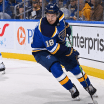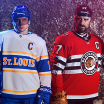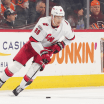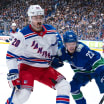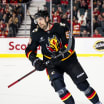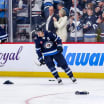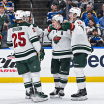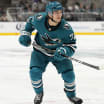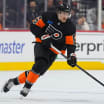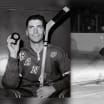Legendary hockey reporter Stan Fischler writes a weekly scrapbook for NHL.com. Fischler, known as "The Hockey Maven," shares his humor and insight with readers each Wednesday.
This week Fischler features a "Strange But True" segment about one of the least-likely endings to a Stanley Cup Final, the 1954 series between the Montreal Canadiens and Detroit Red Wings.
Harvey's miscue in Game 7 cost Canadiens vs. Red Wings in 1954 Cup Final
Defenseman deflected 'pop fly' into own net in overtime to decide championship

By
Stan Fischler
Special to NHL.com
Growing up during the late 1930's in the blue-collar Park Extension neighborhood of Montreal, Doug Harvey emerged as one of the city's best young athletes.
"We played a lot of sports together," Harvey's chum, Larry Zeidel once told me. "Hockey was our favorite game but Doug also was an outstanding baseball player. They said that if he put his mind to it, he could have made it to the majors."
Other neighborhood hockey pals such as future Canadiens Hall of Fame left wing Dickie Moore agreed.
"At the worst," Moore said, "Harvey was good enough to play Double A ball if not better. And he was just as good at football as he was at just about any game he ever tried."
In his personal tug-of-war between deciding on a career in baseball or hockey, Harvey was torn but his chances to make it as a pro tilted toward hockey. It was a wise choice since he'd become one of the all-time best defensemen in the NHL, despite being offered a contract by MLB's Boston Braves.
"Harvey was the greatest defensemen I've ever seen and that includes Bobby Orr, or anybody else," Red Wings legend Ted Lindsay said.
"When you look back at the talent Doug had, and how he could control the speed of a game any way he wanted, he was a great general out there."
Yet on one night in the spring of 1954, Harvey was the centerpiece of one of the strangest endings to a seventh game of a Stanley Cup Final. Most remarkably, Harvey's baseball skills would come into play at the most crucial of times.
The 1954 Stanley Cup Final began at Olympia Stadium in Detroit and the bitterness shared by the players was felt on both sides of the border, not to mention the respective dressing rooms.
"I hated them," Lindsay said. "Hated every one of those Canadiens."
Detroit's Hall of Fame defenseman Marcel Pronovost depicted the animosity in a more visual way.
"If 'Rocket' Richard and I were on the street near the rink at the same time, Rocket would cross the street to the other side so he wouldn't have to talk to me," Pronovost said. "As for the games, there always was electricity in the air."
The charged atmosphere was equally intense when the teams were compelled to ride the same Pullman trains to the next game.
"God, you could hardly look at one another," Montreal goalie Gerry McNeil said. "The train conductor would tell you what time you could go to the club car so both teams wouldn't be there together."
The teams split the first two games of the Final at Detroit's Olympia Stadium and the Red Wings won Games 3 and 4 at the Montreal Forum. But the resilient Canadiens were far from finished.
Irvin benched young goalie Jacques Plante and replaced him with the veteran McNeil. Faced with elimination in Detroit, McNeil helped the Canadiens shut out the Red Wings 1-0 in Game 5, when Montreal's Ken Mosdell scored in overtime.
Riding their momentum, the Canadiens won Game 6 at home 4-1 to set the stage for an epic seventh and deciding game.
Largely due to the heroics of Red Wings goalie Terry Sawchuk, the game was tied 1-1 through regulation.
The contrast between the eventual hero and goat could not have been more stark. Tony Leswick of the Red Wings was an aggressive left wing , who had a down season in 1953-54, scoring six goals in 70 games and another two in the playoffs before Game 7.
Harvey was in his seventh NHL season and his game was on the rise. The following season he'd win the first of seven Norris Trophies as the top defenseman in the NHL. He would later be inducted into the Hockey Hall of Fame in 1973 and was named one of the 100 Greatest NHL Players in 2017.
"Doug was able to control the play," said hockey historian Andrew Podnieks, author of 'Players.' "He could make the game flow to his pace."
Roughly four minutes into overtime, Leswick found himself close to the Detroit bench, far from the Canadiens goal. Richard sped toward Leswick to check him and, hopefully, gain control of the puck.
As Leswick recalled to author Dick Irvin, "I came over the boards in the line change and the puck came right to me. The one thing I didn't want to happen was for me to lose the puck and a Montreal player get a fast break and score. So, I decided to play it safe and loft the puck deep into their end of the rink. I just let it go toward the net.".
Harvey and McNeil converged on the "pop fly," as it would be categorized in baseball.
"I saw it all the way," McNeil told Irvin. "It was just a flip."
Harvey said he figured it would be an easy play and later revealed, "I could read the label on the puck."
Eddie Mazur, the other Canadien forward closest to Leswick, also was following the puck's flight. According to Mazur, it was McNeil's save to make.
"Gerry could have had the shot," Mazur told Irvin. "Gerry had it all lined up. It would have been a simple catch for him."
Most observers believed that Harvey's mistake was trying to do two things at once, push the puck forward and simultaneously launch a counterattack with it.
"Doug thought he'd grab it and go with it," McNeil said. "He tried to play it with his hand, push it in front of his stick. He seemed very sure and I was sure too."
But the puck hit the side of Harvey's hand, changed direction and flew past McNeil into the corner of Montreal's net.
Just about everyone in the packed Olympia Stadium was surprised by the pop-fly winner; except the goal judge who flashed his red light at 4:29 of overtime.
The stunned Canadiens avoided the traditional end of series handshake and went directly to their dressing room.
"It was like the end of the world," McNeil said. "There's no way you can express how you feel at a time like that."



